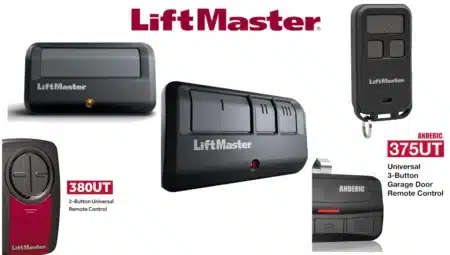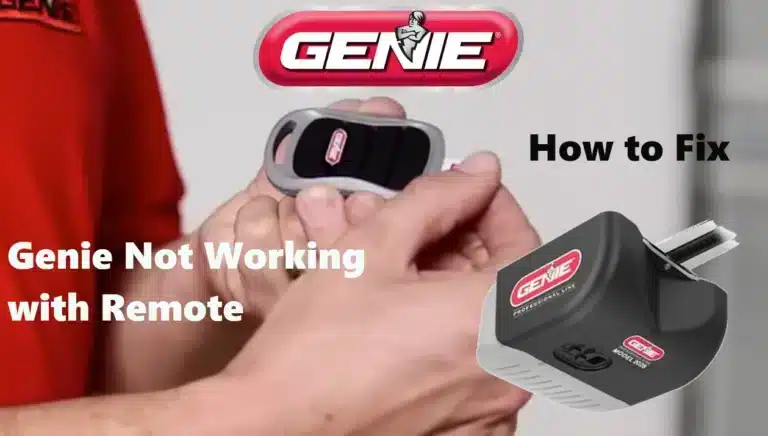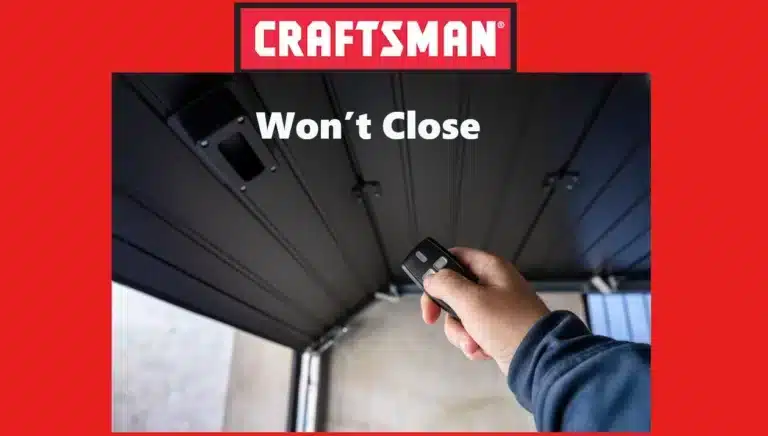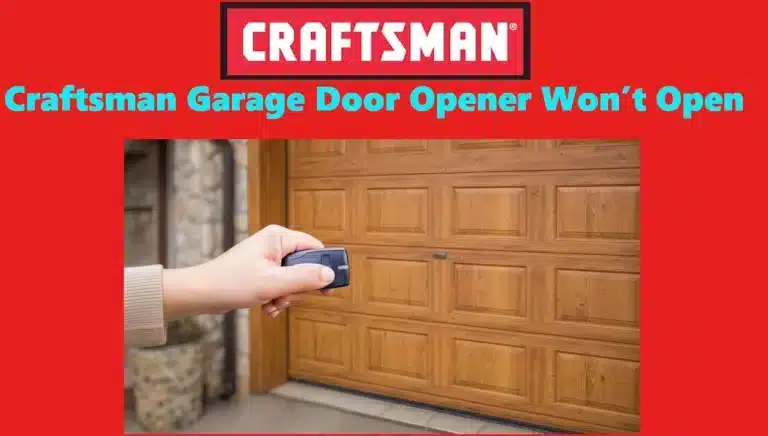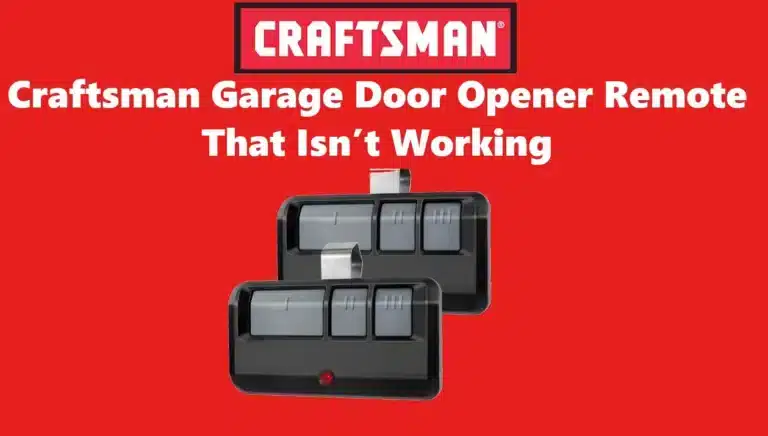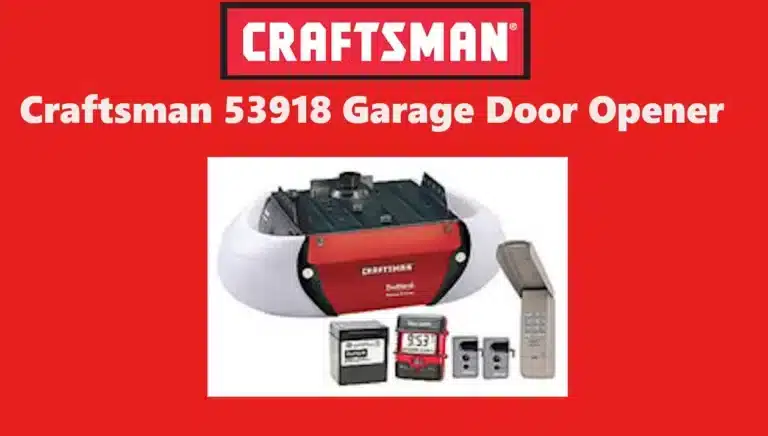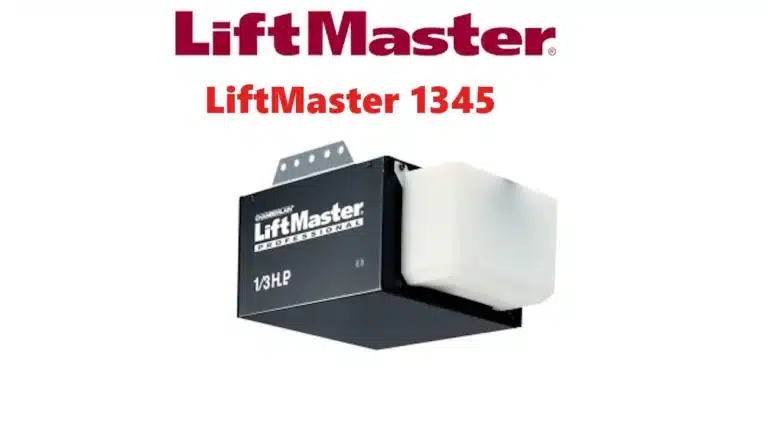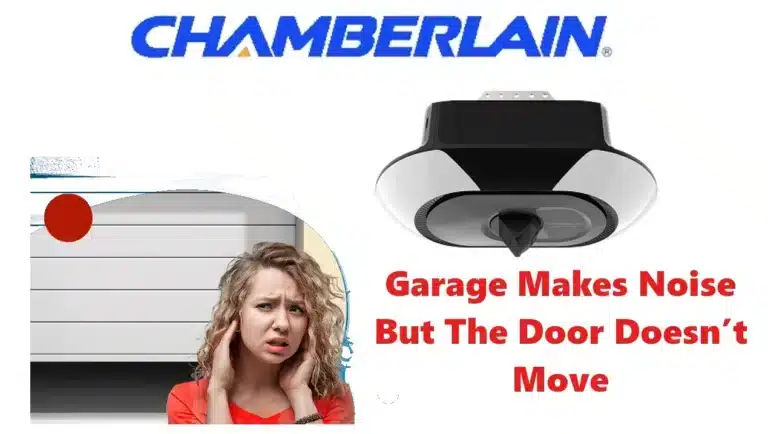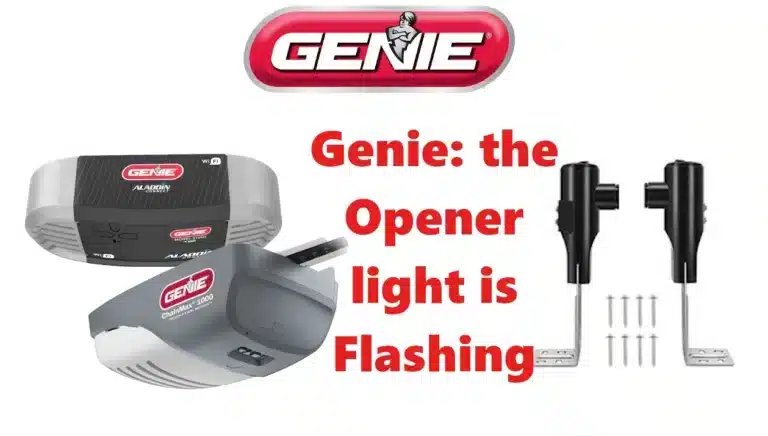Screw drive garage door openers have long been valued for their fast operation and simple, durable design. Major manufacturers like Genie, LiftMaster, Chamberlain, and Craftsman have all produced screw drive models over the years – though today, only a few continue to offer new ones. Below we detail each brand’s current screw drive garage door openers (if available) and highlight notable discontinued models, including their features, strengths, and common issues.
Genie Screw Drive Garage Door Openers
Genie is perhaps the most synonymous with screw drive garage door openers, being one of the few companies still producing new models. Genie’s screw drive openers are known for high lifting power and speed, making them ideal for heavy doors or homeowners who value quick operation.
Current Genie Screw Drive Garage Door Openers
Genie’s current screw drive opener (MachForce Connect model) features a powerful motor, Wi-Fi connectivity (Genie Aladdin app shown), battery backup, and safety sensors.
Genie Signature Series (MachForce Connect) – 2 HPc Screw Drive Opener:
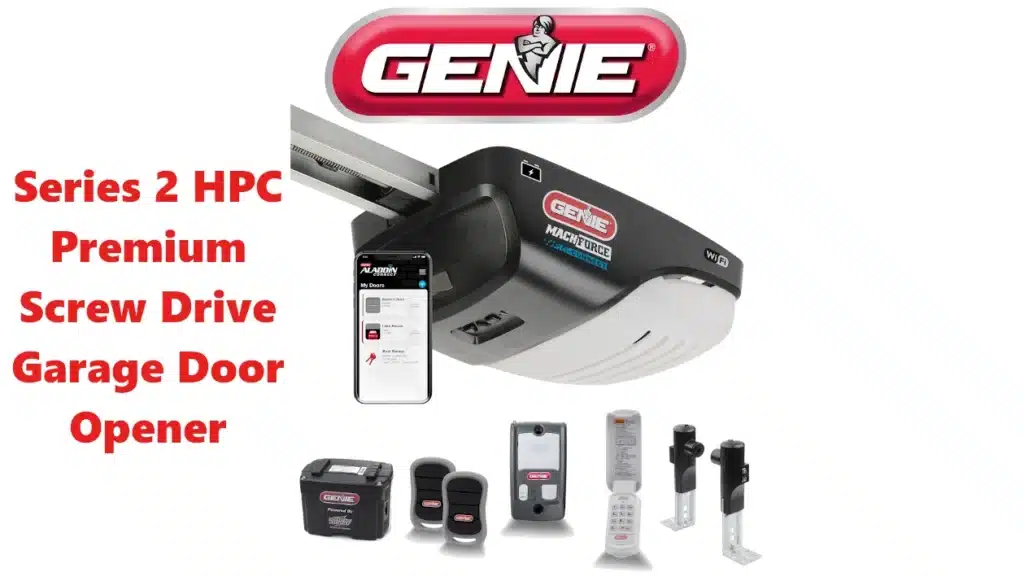
Genie’s flagship screw drive unit (also known as the MachForce Connect, model 4063) uses an ultra-quiet 2 HPc<sup>*</sup> DC motor and a direct-drive steel screw for maximum lifting power and speed. It opens doors up to 12 inches per second – roughly twice as fast as standard belt or chain drives. This opener includes integrated Aladdin Connect® Wi-Fi for smart control via smartphone and is battery backup equipped for operation through power outages. The 140 V DC motor and maintenance-free screw rail provide exceptional strength and durability, suitable for the heaviest residential doors.
It comes with Genie’s Safe-T-Beam® safety sensors, two pre-programmed remotes, a wireless keypad, and a multi-function wall console. (This model is a Home Depot exclusive in the U.S.) In short, the current Genie screw drive opener delivers high performance for those needing speed and muscle in a garage door system, without sacrificing modern conveniences like Wi-Fi and battery backup.
Older/Discontinued Genie Screw Drive Garage Door Openers
Genie Screw Drive Garage Door Openers Excelerator Series:
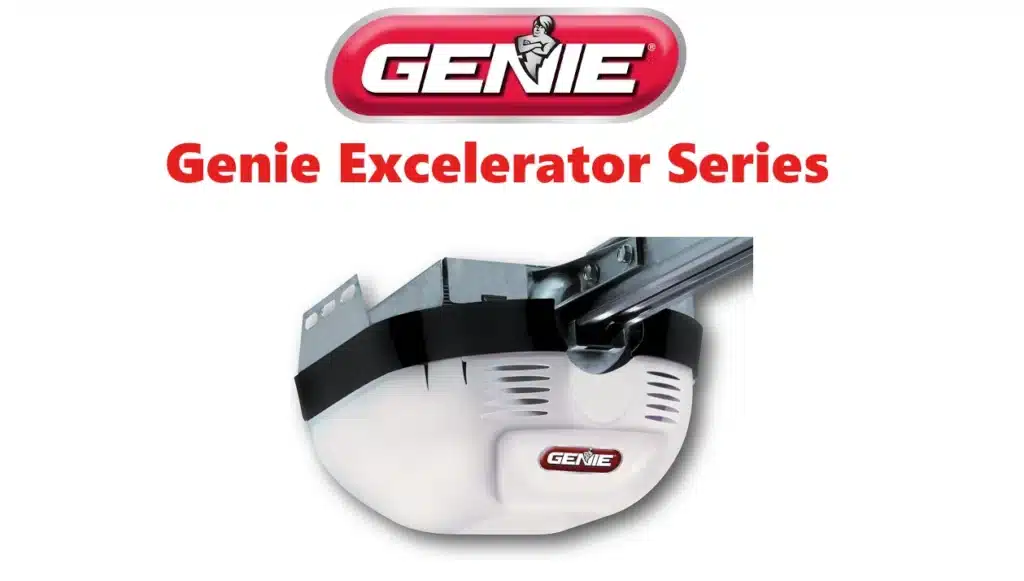
A famous legacy line of Genie screw drive openers, the Excelerator models (e.g. H8000, ISD1000, PRO99, etc.) were extremely popular in the late 1990s and 2000s. These openers were among the first to use Genie’s Intellicode® rolling code security and boasted fast opening speeds (the “Excelerator” name highlighting their quick operation). They came standard with multiple safety systems – Safe-T-Beam® photo-eye sensors, contact reversing, timed auto-reverse, and more – making them compliant with the 1993 safety mandates.
Many Excelerator units are still in service today, and Genie notes that they remain compatible with the company’s current Intellicode accessories like newer remotes and the Aladdin Connect smart kit. This backward compatibility and the availability of replacement parts have helped keep the Excelerator series alive in garages well past their production. A key strength of these models was their opening speed and power, suitable for one-piece heavy doors. On the downside, like most older screw drives, they required periodic lubrication of the screw, and some owners experienced wear of the plastic carriage (trolley) over time – a typical maintenance point for screw drives.
Generation Genie Screw Drive Openers G-Series (G, GX, GXL):
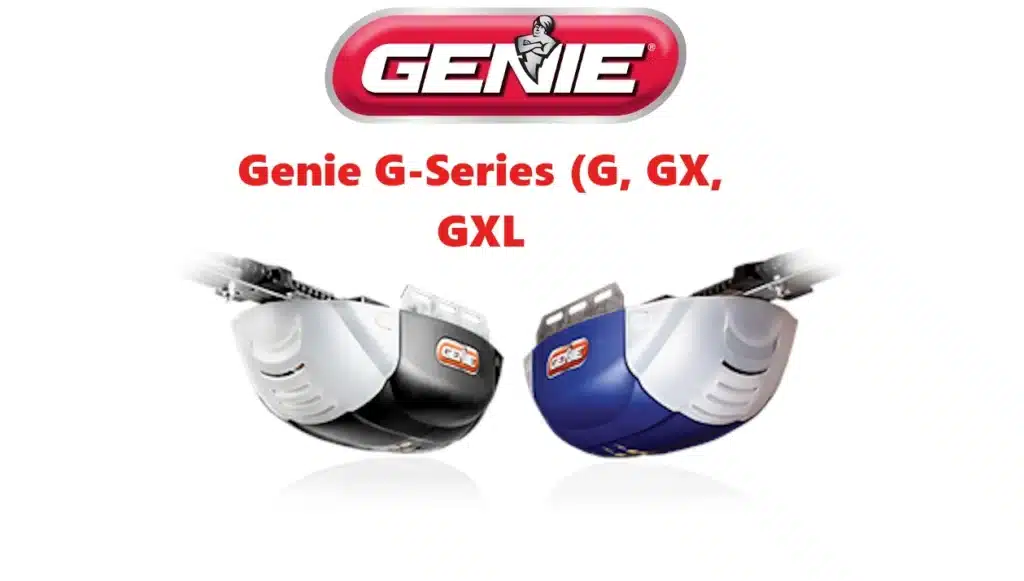
These were earlier-generation Genie screw drive openers dating back to the 1980s and early 1990s. Models in this series (e.g. G5000, GX9000, GXL10000 “Medallion” series, and others) featured the classic Genie screw drive mechanism and robust AC motors. They earned a reputation for longevity – many are still running decades later – but they predated modern safety standards. In fact, some G/GX/GXL units did not include Safe-T-Beam sensors originally (photo-eye sensors became mandatory on U.S. openers in 1993).
Owners of these legacy units often retrofitted sensors or have to be mindful of safety. Genie supports these older models with limited spare parts (like screw couplers, carriages, etc.), though availability is increasingly limited. Common issues on these classic units include wear of the screw coupler (usually a plastic connector between motor and screw) and the need for proper screw lubrication to prevent binding in extreme temperatures. Still, their simple design and strong motors are fondly remembered – they were straightforward workhorses that introduced many homeowners to the idea of a fast, reliable screw drive opener.
Genie Screw Drive Openers PowerMax and TriloG Series:
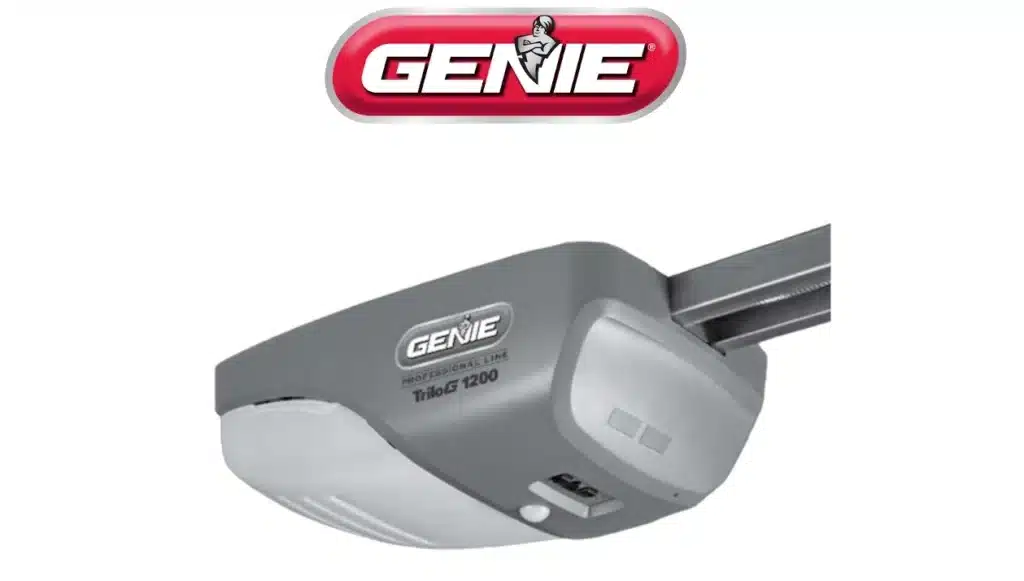
In the early 2010s, Genie introduced the PowerMax (retail) and TriloG (professional Genie Pro line) screw drive openers, which were high-end at the time. Models like the PowerMax 1200/1500 and Genie Pro TriloG 1200/1500 offered 3/4 HPc to 1 HPc motors, Soft Start/Stop control, and GenieSense™ monitoring. These units were powerful and featured DC motors with even faster speeds (similar to the Excelerator’s performance). They also included compatibility with Genie’s early network systems.
However, an important note in this series’ history: certain production runs were subject to a recall in 2014 due to an overheating control board issue. Genie addressed this with replacement boards, and the issue was limited in scope (affecting units sold ~2011–2012). Aside from the recall, the TriloG/PowerMax openers had a strong performance reputation – fast and forceful – but like other screw drives, they were somewhat loud and required routine greasing. Many of these units carry lifetime warranties on the motor and screw and are still supported by Genie for parts.
In summary, Genie’s discontinued screw drive openers – from the earliest GXL models up through Excelerator and TriloG – are remembered for speed, power, and durability. Their typical weaknesses were noise (especially older AC motor models) and maintenance needs (keeping that screw drive lubricated, and occasionally replacing wear items like the carriage or coupler). Overall, Genie’s legacy in screw drives is vast, and it continues in their modern offerings today.
LiftMaster Screw Drive Garage Door Openers
LiftMaster (a professional brand under the Chamberlain Group) built a reputation for high-quality garage door openers. While most of LiftMaster’s lineup has been chain, belt, or wall-mounted jackshaft drives, they did produce screw drive garage door openers in the past. These were often marketed as robust, low-maintenance openers suitable for varying climates. Today, LiftMaster no longer manufactures new screw drive models, focusing instead on quieter belt drives and other technologies. However, their discontinued screw drive units remain in use and are supported with replacement parts.
Current LiftMaster Screw Drive Garage Door Openers
LiftMaster does not offer any current screw drive garage door opener models. In recent years, the company has omitted screw drives from its lineup due to shifting consumer preferences (toward quieter belt drives and smart features). Homeowners seeking a screw drive under the Chamberlain/LiftMaster umbrella are generally pointed toward Genie’s offerings or old stock, as LiftMaster’s screw drive expertise lies in its older models.
Notable Older LiftMaster Screw Drive Garage Door Openers
LiftMaster 3240 (1/2 HP) Screw Drive Garage Door Openers:
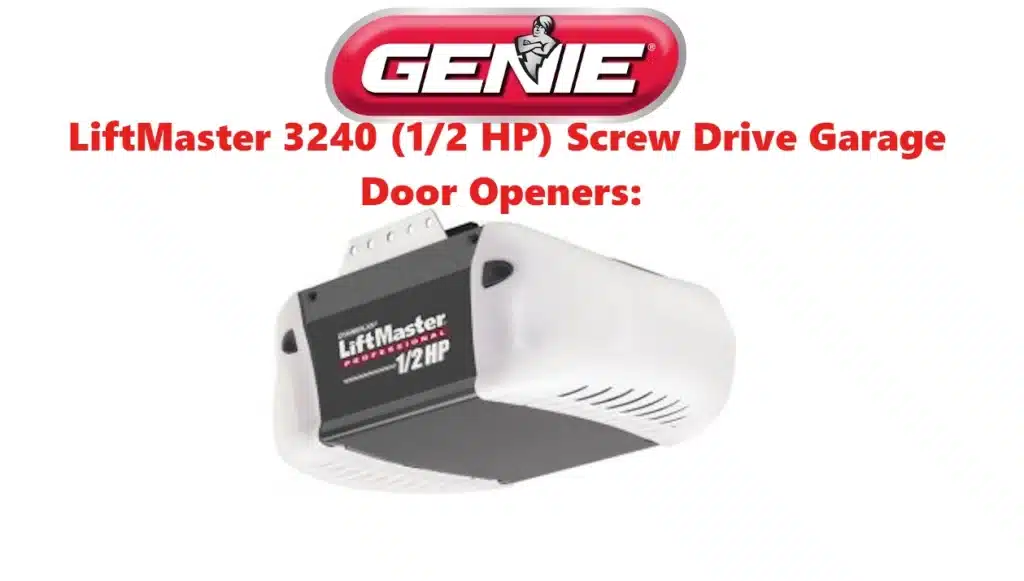
This was a popular 1/2 horsepower AC motor screw drive opener from LiftMaster’s mid-2000s Security+® series. The 3240 was designed to be smooth-running even in extreme temperatures, thanks to a specially engineered drive system. Uniquely, LiftMaster’s engineers replaced the traditional two-piece plastic liner and aluminum screw rail with a one-piece galvanized steel rail, significantly reducing friction and eliminating the need for periodic lubrication. This made the 3240 virtually maintenance-free compared to earlier screw drives. It also featured MVIS® (Motor Vibration Isolation System) to minimize noise and vibration, so despite having an AC motor, it operated more quietly than older designs.
Key features included electronic limit and force programming (the “Smart Garage Door Opener®” system for easy code and travel setup), 200W lighting, and all standard safety features (The Protector System® photo eyes, auto-reverse on obstruction, etc.). The LiftMaster 3240 came with Security+ rolling-code remotes and was typically packaged with two transmitters, a multi-function wall console, and an outdoor keypad. It carried a lifetime motor warranty (reflecting confidence in its build) and a year on parts.
Overall, the 3240 earned a reputation as a reliable, heavy-duty opener best suited for homeowners who wanted strength and could tolerate a bit more noise than belt drives. Common issues over the long term included wear on the plastic trolley (screw rider) and the plastic drive coupler – both considered normal maintenance parts on screw drives. LiftMaster’s use of plastic in these components meant they would occasionally strip or break under heavy use, but replacements were inexpensive.
LiftMaster 3130 (1/3 HP) Screw Drive Garage Door Openers:
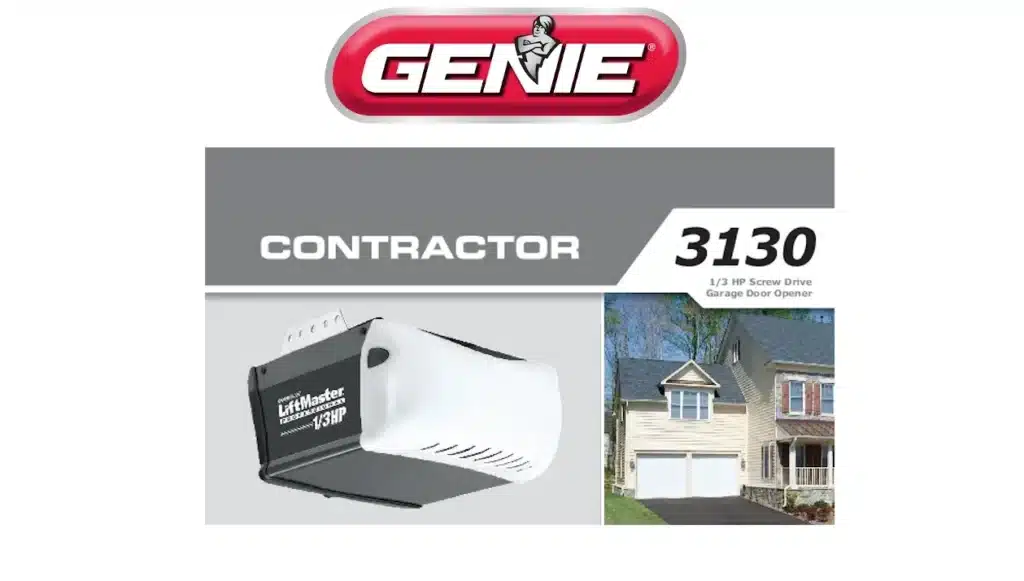
A “contractor series” cousin of the 3240, the 3130 was a 1/3 horsepower screw drive opener. It shared many of the same design elements – including the maintenance-free one-piece screw rail and MVIS noise reduction – but with a smaller motor suited for standard single garage doors. The 3130 was often an entry-level professional model (marketed to builders or as a cost-effective choice) and provided solid, if slower, performance. It also supported Security+ remotes and the full range of safety features (safety sensors, etc.).
With a lighter-duty motor, it wasn’t recommended for oversized or extremely heavy doors, but for a typical 7-foot single door it was sufficient. Like the 3240, it had a smooth operation for a screw drive and required minimal upkeep beyond keeping the rail clean. Its durability was good for its class, though the same coupler and trolley wear points applied over time. LiftMaster discontinued the 3130/3240 series as belt drive technology advanced, but replacement parts (like screw couplers, trolley “rack” assemblies, and circuit boards) remain available to support homeowners who still rely on these units.
Other LiftMaster Screw Drive Models:
Earlier in the 1990s, LiftMaster’s screw drive offerings were limited. The brand primarily sold chain drives then, with screw drives more commonly seen under the Chamberlain and Craftsman names (for retail markets). It’s worth noting that LiftMaster’s screw drive models were essentially the pro-grade equivalents of Chamberlain’s consumer units. Thus, a model like the 3240 corresponds to a Chamberlain model (and to Sears Craftsman variants) with similar specifications. All of these used Chamberlain’s core design featuring an AC motor with MVIS, a rigid screw rail, and Security+ coding.
Performance and Issues Of Liftmaster Screw Drive Garage Door Openers:
LiftMaster’s screw drives were praised for being tough and relatively quiet for their type. They excelled in harsh climates, as there were no belts to slip in heat or chains to stiffen in cold – the screw mechanism operated reliably across temperature extremes. The completely sealed, pre-lubricated rail in later models also prevented the common “grease drips” that plagued older screw drives; homeowners didn’t have to worry about lubricant splattering on cars or floors.
The main drawbacks were the noise level, which, while mitigated by MVIS, was still higher than today’s ultra-quiet belt drives, and the eventual wear of plastic parts (the drive coupler and trolley “nut”). When those parts failed, the opener would temporarily be unable to move the door until they were replaced. Many LiftMaster screw drive owners learned to keep a spare coupler on hand due to this expected maintenance cycle. In general, these units would last a long time (often 10+ years) with periodic part replacements and continue to be supported by LiftMaster’s parts network.
Chamberlain Screw Drive Garage Door Openers
Chamberlain is the consumer brand of the Chamberlain Group, often sold in home improvement stores. In the past, Chamberlain offered screw drive garage door openers as part of its lineup, though today the brand has phased out screw drive models in favor of belt and chain drives. Chamberlain’s screw drive units were known under names like “Premium Power Drive®”, emphasizing heavy-duty performance. They typically mirrored the LiftMaster designs (with similar model numbers) but were geared for DIY installation. No current Chamberlain screw drive openers are on the market as of 2025, but several older models remain noteworthy.
Current Chamberlain Screw Drive Garage Door Openers
Chamberlain does not currently manufacture screw drive garage door openers. The last screw drive models in Chamberlain’s range have been discontinued for several years. Homeowners seeking a Chamberlain-brand opener today will find belt-drive, chain-drive, and wall-mount options, with screw drives no longer offered due to decreased demand (belt drives achieved comparable strength with much quieter operation, reducing interest in screw drives).
Notable Discontinued Chamberlain Screw Drive Garage Door Openers
Chamberlain Premium Power Drive (PD Series):
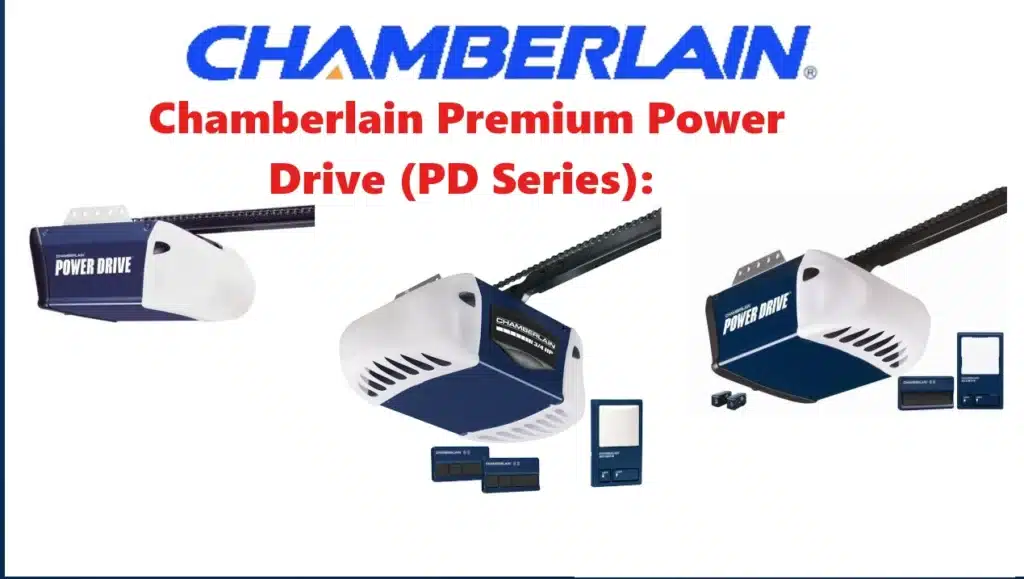
Chamberlain’s primary screw drive offerings were in the PD400-series. Models such as PD420, PD460 (and variants like PD420-2, PD460-2K) were 1/2 HP AC screw drive openers. These were marketed as strong and reliable, intended for homeowners who needed heavy-duty lifting for one-piece or heavy sectional doors. The PD series incorporated Chamberlain’s Motor Vibration Isolation System (MVIS®) to dampen noise, similar to LiftMaster equivalents. They also featured a “Quick-Install” one-piece rail, simplifying the assembly process for DIY installers despite the unit’s size.
Like other Chamberlain openers of the late 1990s–2000s, they provided 200 watts of lighting, used Security+® rolling code remotes for security, and included a full suite of accessories: typically two 3-button remotes, a wireless keypad, and a multi-function wall control panel. The lifetime motor warranty on these models underscored their heavy-duty build, and many operated for a decade or more. In terms of performance, the PD screw drives were known for steady, powerful operation, albeit with the characteristic screw drive noise (a loud, rapid metallic whir). They required minimal maintenance aside from occasionally checking the screw for proper lubrication.
Common issues were akin to the LiftMaster units – the plastic trolley (drive “nut”) wearing out or the screw coupling degrading after years of stress. Chamberlain provided replacement part kits (and even upgrade kits that sometimes improved part durability) through its dealers to keep these units running. Overall, the Premium Power Drive screw openers had a good reputation for strength and reliability in their era. They were an excellent choice for large or heavy doors before ultra-quiet belt drives became prevalent.
Chamberlain Whisper Drive Screw (PD432):
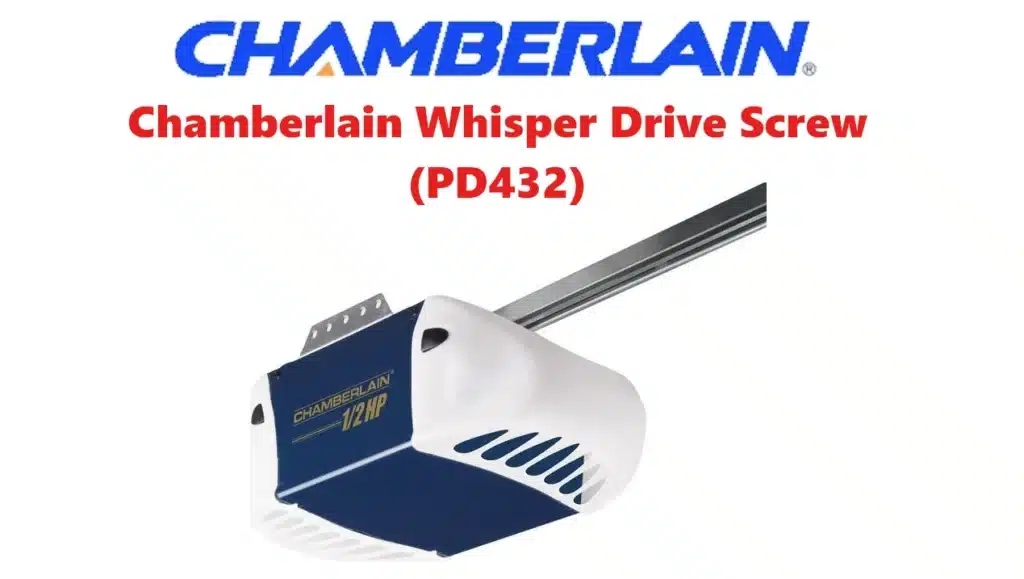
Toward the end of Chamberlain’s screw drive run, certain models like PD432D were introduced, sometimes branded with terms like “Whisper Drive” despite being screw drives. These late-generation units tried to incorporate additional noise reduction (possibly refined motor isolation and a softer start/stop) to appeal to consumers sensitive to sound. They retained the 1/2 HP rating and all the standard features of the PD420/460 series. The PD432D was sold at retailers like Lowe’s and came with similar accessories. Its “whisper” marketing suggested improved noise performance, though in practice it was only marginally quieter than earlier models – still louder than a belt drive opener. The PD432 and its kin were among the last Chamberlain screw drives on the market, as Chamberlain shifted focus to belt drives with built-in Wi-Fi around the mid-2010s.
Chamberlain’s discontinued screw drive openers, much like LiftMaster’s, benefitted from strong build quality and were a favorite for those needing a robust, no-frills opener. Their strengths were lifting power and durability, while their weaknesses were noise and vibrations (mitigated but not eliminated by MVIS) and the maintenance of moving parts (ensuring the screw and trolley were in good shape). Since Chamberlain is under the same corporate umbrella as LiftMaster and Craftsman, many parts are cross-compatible.
This has allowed homeowners with old Chamberlain screw drives to find spare parts (rails, carriage assemblies, circuit boards, etc.) easily, extending the life of these units. However, as time goes on, complete replacement is often recommended – Chamberlain themselves encourage upgrading to newer drive systems rather than repairing very old screw units, given the advancements in quietness and connectivity.
Craftsman Screw Drive Garage Door Openers
Craftsman (formerly sold by Sears) partnered with Chamberlain to offer garage door openers that often mirrored Chamberlain’s models under different branding. Craftsman sold numerous screw drive garage door openers from the 1980s through the early 2010s, making them a common sight in garages across America. These openers usually carried Sears model numbers (starting with “139.”) but shared technology and parts with Chamberlain/LiftMaster equivalents.
Craftsman screw drive openers were popular among DIY installers and came in 1/2 HP and 3/4 HP variants, covering standard and heavier door needs. In recent years, Craftsman (now a Stanley Black & Decker brand) has shifted to belt and chain drive units with smart features, and new screw drive models are no longer being produced under the Craftsman name. Still, many older Craftsman screw drive openers remain in use and are fondly remembered for their reliability.
Current Craftsman Screw Drive Garage Door Openers
There are no current Craftsman-branded screw drive openers on the market. After Sears ceased its hardware operations, the Craftsman brand was relaunched with a focus on belt and chain drive openers that incorporate modern features like smartphone connectivity (often via Chamberlain’s myQ technology). Homeowners looking for a new screw drive opener in the Craftsman lineage would effectively be directed to Chamberlain/LiftMaster’s offerings (which, as noted, have discontinued screw drives) or to Genie’s models. Thus, any “current” Craftsman screw drive unit would simply be remaining stock of older models.
Older Craftsman Screw Drive Garage Door Openers
Craftsman 1/2 HP Screw Drive Models:
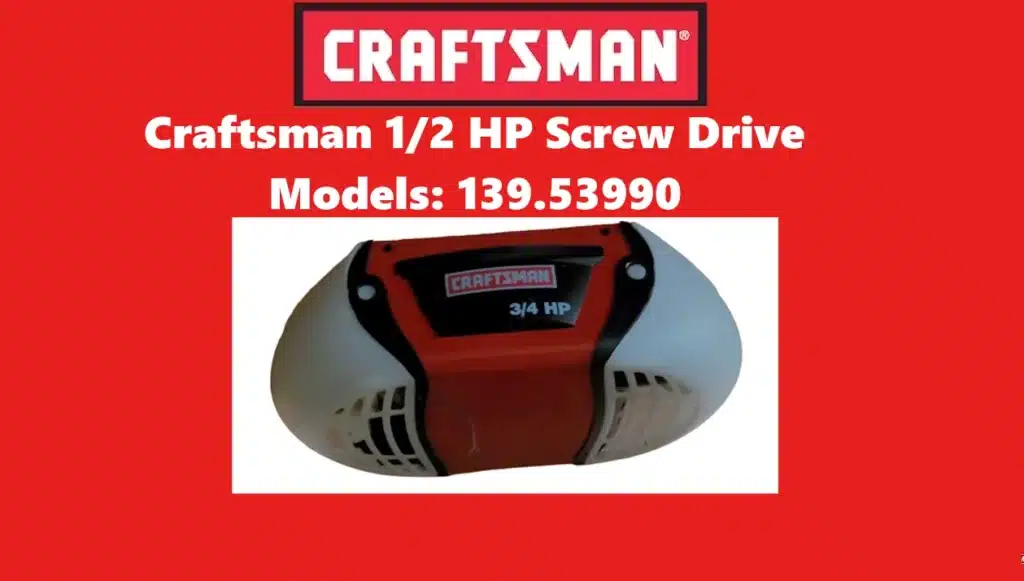
Sears offered several 1/2 HP screw drive openers over the years, typically identified by model numbers such as 139.53990, 139.53991SR (and various suffixes for minor revisions). These units corresponded roughly to Chamberlain’s PD420 series – they featured the MVIS® for noise reduction, a one-piece screw rail in later models, and Security+® rolling code remotes for security, just like the Chamberlain versions. Sold as a complete kit, a Craftsman screw drive opener would come with two or three remote controls, a wireless keypad, and wall control, making it a great value package for homeowners.
Craftsman emphasized easy installation and dependability in their marketing. Many of these 1/2 HP units were installed in the late 90s and 2000s and are still functioning today – a testament to their build. They excelled at lifting standard sectional doors and one-piece tilt-up doors, often faster than chain drives (though not as fast as Genie’s high-speed models). Owners appreciated that these openers had fewer moving parts (no chain or belt), translating to less adjustment over time. Common maintenance issues included the same screw drive foibles seen elsewhere: the plastic drive carriage wearing out (resulting in a grinding screw with no door movement) and the need to occasionally replace the screw coupler if it cracked.
Craftsman made repair easy by supplying parts through Sears PartsDirect and using the ubiquitous Chamberlain components. Another quirk of older Craftsman screw drives was the need to use the correct lubricant – Sears sold a special low-temperature lithium grease for these openers, since general greases could harden in winter and cause the opener to struggle. When properly maintained, a Craftsman 1/2 HP screw drive opener was known to last 10–15 years or more, which was on par with – or better than – other opener types of the era.
Craftsman 3/4 HP “DieHard” Screw Drive Models:
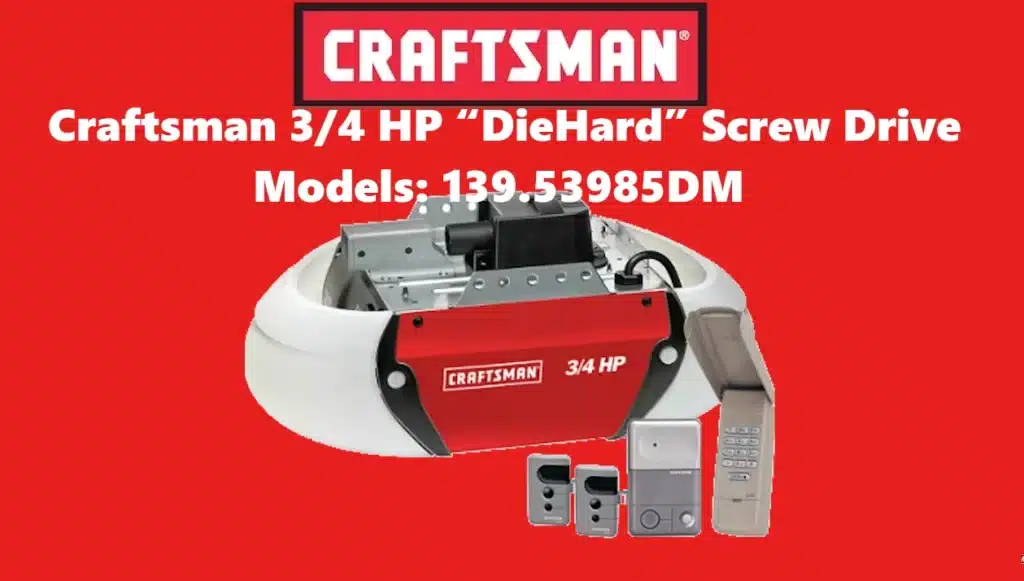
For larger or heavier doors, Sears offered 3/4 HP screw drive openers, sometimes co-branded with the “DieHard” name (after the famous Sears DieHard battery, indicating a stronger, premium product). These models (e.g., 139.53985DM and similar) were essentially the Craftsman version of Chamberlain’s 3/4 HP screw drives, built to handle carriage house doors, wood doors, or oversized double doors. They included all the upgraded features – often coming standard with a motion-detecting wall control, a battery backup (in later models), and extended rails for taller doors.
The 3/4 HP Craftsman units had plenty of power and slightly faster door travel than the 1/2 HP units. They retained the core screw drive advantages of direct drive power and fewer parts, but amplified the typical drawbacks: these larger motors could be quite loud and produced notable vibration on the opener header. Sears addressed this by continuing to use MVIS isolation mounts and by marketing the openers as suitable for detached garages or those where noise was less a concern. A strength of the 3/4 HP Craftsman screw drives was their ability to handle heavy double doors with ease – something that chain drives of equivalent horsepower did, but belt drives of that era struggled with.
Their performance reputation was generally positive: they opened big doors reliably and slightly quicker than a chain drive, making them a favorite for those who had, say, a solid wood door. On the issue side, the higher torque put even more stress on the same plastic components (coupler and trolley), meaning those often needed replacement within 5-7 years. Additionally, if not kept properly lubed, the screw could create a lot of friction, sometimes leading the opener to overheat or shut down temporarily (thermal protection would kick in). Still, with proper care, many of these 3/4 HP units lived long lives as well. Sears provided lifetime warranties on the motor for many models, giving consumers confidence. Today, you’ll find a fair number of these older Craftsman screw drive openers still installed, though many have been retrofitted with modern Chamberlain or LiftMaster belt drives for noise reduction.
Notable Traits and Legacy:
Craftsman screw drive openers, being essentially rebranded Chamberlains, carry the legacy of that design: they were workhorse openers that prioritized function over form. They were not the quietest machines, but they were dependable and strong, which is why so many remained in service. They also introduced a generation of homeowners to DIY garage door opener installation – Sears manuals were detailed, and the quick-assemble screw rails (especially the one-piece designs in later kits) made it feasible for a competent homeowner to set one up on a weekend.
Many Craftsman units even included helpful features like auto-force sensing (adjusting force based on door movement each cycle) and diagnostics via flashing LED codes, aiding in troubleshooting. By the mid-2010s, Sears had largely stopped selling screw drives as quieter technology took over. However, the influence of Craftsman’s screw drive era persists: in countless forums and Q&A sites, you’ll find homeowners with a 15- or 20-year-old Craftsman screw drive opener seeking advice on whether to repair or replace – a testament to how long these devices lasted and how well-supported they were. Most experts today would advise replacing with a new model (belts or jackshaft openers with smart features), citing that screw drive technology is “less common now” and somewhat outmoded. But for those who have one running well, the common refrain is: why mess with what still works?
In conclusion, Craftsman’s screw drive garage door openers were a significant part of the opener landscape in their time. They offered the average homeowner a combination of power, DIY-friendliness, and value. Their legacy is carried on indirectly through the continued support of Chamberlain parts and the memories of that unmistakable sound of a Craftsman screw drive raising the garage door – a little loud, perhaps, but confident in its task.

